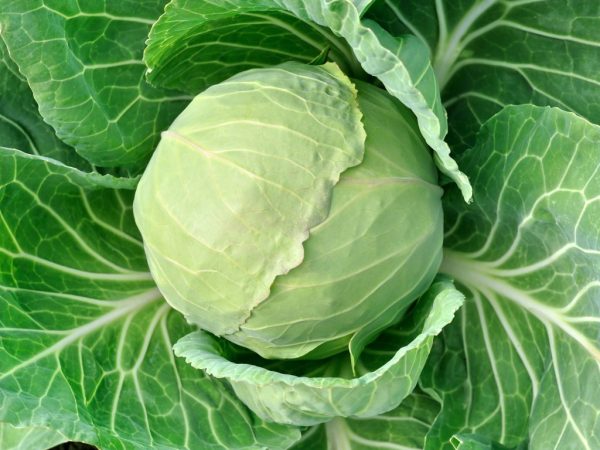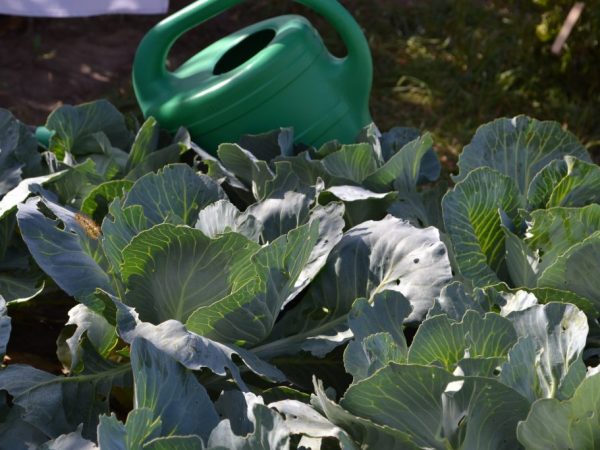Description of cabbage variety Stone head
Some of the most unpretentious varieties of cabbage are late-ripening varieties. White cabbage Stone Head is a representative of this category.

Description of cabbage variety Stone Head
Description of the variety
Cabbage variety Stone Head is resistant to cold, extreme heat and drought. The cover leaves are green. The plant is light-requiring. Lack of light negatively affects the quality of the fruit. Productivity from 1 sq. m - 8-11 kg.
Description of fruits
The fruits of the stone head cabbage variety have the following characteristics:
- the head of cabbage has a round shape and dense structure;
- ripe fruit reaches a weight of 3-4 kg or more with good care;
- marketable ripeness of the fruit occurs in 119-126 days;
- the fruit contains a lot of sugar.
Cabbage is versatile in its preparation and storage. It is eaten raw, fermented, boiled. Stored until the end of winter if the necessary conditions are met. By this time, taste has changed, but only for the better. When ripe and storage conditions are observed, the head of cabbage does not crack.
Because of its name, this variety is often confused with Kamennaya Golovaya 447. This is a red cabbage, it is not so resistant to cracking and is used only fresh.
Growing and care
Seed preparation
Before planting cabbage seeds Stone Head are hardened and disinfected. For hardening, the seeds are first placed in hot water for 15-20 minutes.
The water temperature should not exceed 50 ° C. After that, the seeds are cooled in cold water at a temperature not lower than 18 ° C. This procedure also kills most of the bacteria found on the seeds.
Landing
The seeds can be planted both in the greenhouse and in the open ground. Sowing time is April or early May.
Seeds are planted in the greenhouse at the rate of 3-4 g per 1 sq. m. In open ground, seeds are sown at the rate of 0.15-0.20 g per 1 sq. m. In cold weather, the soil is covered with a film. Planting depth - 1-2 cm.
Seedlings are transplanted when the first 5-6 leaves are formed. Can be transplanted into a greenhouse or directly into open ground at a distance of 0.7 x 0.7 m.
The plant is regularly loosened and huddled. Loosening is carried out to a depth of 10 cm. Seedlings are fertilized with a solution of 1 tbsp. l. superphosphate and 1 tbsp. ash per 10 liters of water.
Watering

Plants need regular watering
Despite its adaptability to heat, the crop needs regular watering. For the homemade cabbage variety Stone Head, the description of the irrigation scheme looks like this:
- The first 2 weeks, cabbage is watered abundantly: every 2 days, 8-10 liters per 1 sq. m landing.
- After 2 weeks, watering is reduced to once a week. Water consumption remains the same: 10 liters per 1 sq. m. Pour 1 liter under the bush.
- At the time of the ovary of the heads of cabbage, the amount of water under the bush is increased to 3-4 liters.
For the purpose of prevention, watering is stopped 2 weeks before harvesting.
Top dressing is added with water. The plant planted in the ground is fed up to 3 times. The first top dressing is applied 2 weeks after planting in the ground.
In the first feeding, plants are watered with a solution of ammonium nitrate at the rate of 10 g per 10 liters of water. After 10 days, the plants are fed with a mullein 0.5 liters per 10 liters of water.To strengthen the plants, 20 g of superphosphate, 10 g of potassium nitrate, 10 g of urea are added to the solution.
For the ovary of heads of cabbage at the end of June, plants are fed with potassium (40 g per 10 l of water) and phosphorus (20 g per 10 l of water). Cabbage is very sensitive to the presence of fertilizers in the soil, therefore, the recommended doses must be strictly observed.
Storage
Cabbage is harvested for storage before the onset of frost in dry weather. The average daily temperature should be in the range of 4-7 ° C. The collection period is late September and early October.
For storage, choose medium-sized cabbage. Small and medium are consumed immediately. In preparation for storage, the head of cabbage is cleaned of integumentary leaves, 3-4 leaves are left, the stump is cut with a straight cut.
Storage temperature - 0-5 ° С. Shelf life is 7-8 months.
Pests
Tempering and disinfection do not protect against insects. Heads of cabbage love slugs, caterpillars, aphids and flies.
Description of preventive measures and pest control:
- To fight slugs, crushed eggshells or coarse sand are poured around the heads of cabbage. If they are already on the plant, they are harvested by hand. Can be sprayed with mild saline, ammonia (1 part to 6 parts water) or strong coffee.
- Cabbage caterpillars are collected by hand in the daytime. Spray with a solution of "Bankol" at the rate of 8 ml per 10 liters of water.
- Cabbage aphid. The larvae are harvested by hand. Then the plants are treated with a solution of wood ash. For its preparation, 250 g of ash is mixed with 10 liters of water.
Alternative methods are also used against pests. Heads of cabbage are sprinkled with onion and garlic infusions. You can use tomato tops, wormwood, tansy, celandine, hot peppers and citrus fruits. To prepare tinctures, the selected agent is crushed and poured with warm water. The solution is infused for 2-3 days, and then filtered, diluted with water and sprayed with plants.
Diseases
Disease prevention begins with seed treatment. Poor quality and unprocessed seeds are the main cause of all diseases of future plants.
Description of the main methods of disease control:
- Powdery mildew or brown spots. The leaves affected by the disease are removed. The plant is treated with a 1% solution of Bordeaux liquid.
- Root rot, or black leg. To prevent the development of this disease, monitor soil moisture. Diseased plants are removed. Plants are watered with wood ash tincture at the rate of 1 tbsp. ash per 1 liter of water.
- Rhizoctonia. The leaves become transparent, then brown, bloom and rot. For the prevention of seeds and seedlings use the drug "Fitolavin". For adult plants, drugs are used with the main active ingredient - copper oxychloride.
- Keela or brown growths on roots. Dead plants are destroyed. The soil is treated with a solution of colloidal sulfur at the rate of 40 g per 10 l of water.
For the prevention of diseases, folk remedies are also used, but they are mainly used for early-ripening varieties in order to avoid the toxicity of the fruit. Late-ripening species tolerate heavy agrochemicals.
Conclusion
Kamennaya cabbage is chosen for growing in a summer cottage, since it is resistant to adverse conditions and is stored for a long time. With good care and proper watering, the taste of cabbage can significantly improve.


